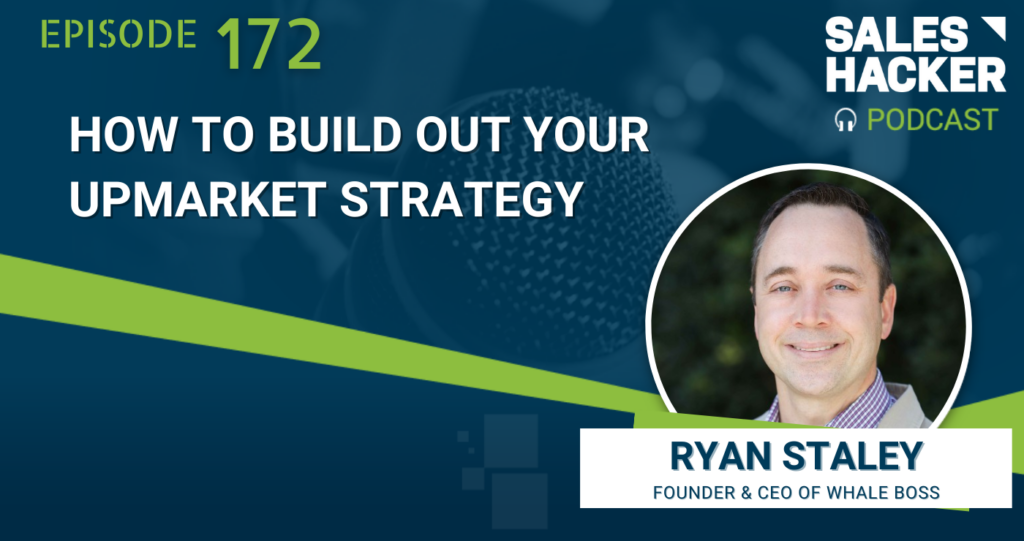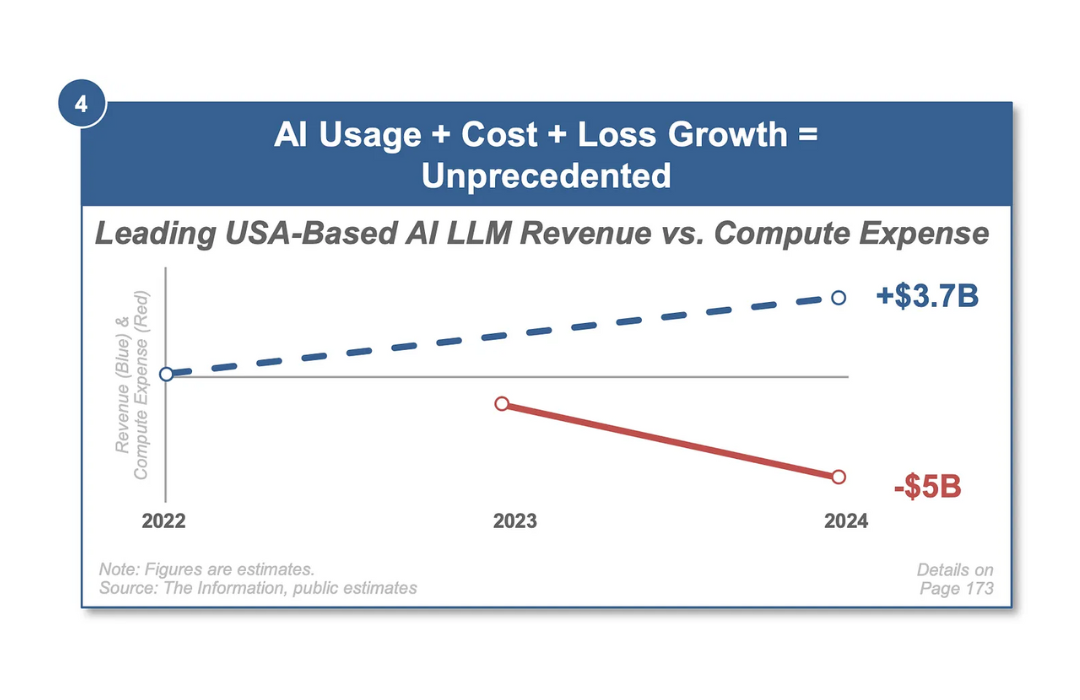In this episode of the Sales Hacker Podcast, we have repeat guest Ryan Staley, CEO at Whale Boss and fellow podcast host at Sales and Marketing Built Freedom. Join us for a great conversation about why you don’t have to boil the ocean when moving upmarket and the best ways to position your company for enterprise sales success.
If you missed episode 171 check it out here: How to Hire Salespeople with the Future In Mind with Anjulika Sain
What You’ll Learn
- Framing the economic impact of moving upmarket
- Why companies should verticalize
- Building an enterprise sales motion gradually
- Strategies for raising money… or not
Subscribe to the Sales Hacker Podcast
Show Agenda and Timestamps
- Ryan Staley & Whale Scale [3:15]
- Your biggest enterprise sales mistake [7:23]
- Implementing a winning deals-tracking system [14:30]
- Why your org doesn’t need funding [18:26]
- Paying it forward: shout-outs [28:55]
- Sam’s Corner [32:46]
Show Introduction [00:00]
Sam Jacobs: Welcome to the Sales Hacker Podcast. Today on the show we’ve got Ryan Staley. Ryan runs a business called Whale Boss, and it’s all about selling to the enterprise. He’s also the chapter head for the Chicago chapter of Pavilion.
We’ve got three sponsors. The first is Outreach. They triple the productivity of sales teams, empowering them to drive predictable and measurable revenue growth by prioritizing the right activities and scaling customer engagement with intelligent automation. Outreach makes customer-facing teams more effective and improves visibility into what really drives results.
The second sponsor is Pavilion. It’s my company. Pavilion is the key to getting more out of your career. Our private membership connects you with a network of thousands of like-minded peers and resources, where you can tap into leadership opportunities, training, mentorship, and other services, including a full suite of courses offered through Pavilion University, 99% of them included in your membership. Unlock your professional potential with a pavilion membership. Leaders at every stage can get started today at joinpavilion.com.
And our newest sponsor, Blueboard!
Cash rewards — they feel like a slap in the face, don’t they? That’s why you’ve gotta check out Blueboard. It’s an incredible company. They provide experiential sales incentives and President’s Club trips. It’s the world’s leading experiential sales recognition platform offering top reps your choice of hand curated experiences from skydiving, to court side tickets, Michelin star dinning, to 5-star spa escapes. Do you need that wonderful Reiki massage? Or maybe a deep Swedish tissue massage? You can get that through Blueboard.
For President’s Club, Blueboard offers individual bucket list trips and luxury home goods from Peloton bikes to swimming with whale sharks in Cabo, yoga retreats in Bali, to chasing the Northern Lights. Treat your reps like the rockstars they are, after they pick their favorite experience.
This is one the the best parts: It’s not just that you pick the experience, it’s that you get a concierge. You get a dedicated Blueboard concierge who will plan all of your logistics and itinerary so you don’t have to lift a finger. Check them out podcast.blueboard.com to get your free demo.
Without further ado, let’s listen to my conversation with Ryan Staley.
About Ryan Staley & Whale Scale [3:15]
Sam Jacobs: You’re just more great guest. So I mentioned Whale Boss, but let’s give you an opportunity. What does Whale Boss do?
Ryan Staley: Sure, man. So basically, the name is crafted because we grew an enterprise team from zero to 30 million in annual reoccurring revenue at my last company, when I was kind of tasked to create an enterprise sales motion from scratch, everything from the playbooks to the team. How we survived due to intense pressure from our CEO and investors was to constantly scale up and continue to bring in whales. So right now what I do is I help tech startups or mature tech companies scale and expand their revenue through what I call a revenue sprint, which is a three-month consulting engagement so that they can implement a seven or eight-figure sales system via three different methods that I’ve kind of coined.
Those were the first principles behind that revenue growth strategy. So that’s what I’m doing right now. I love it. I love working with CEOs. It’s so much fun. And they like to make shit happen in a really fast manner that aligns well with me.
Your biggest enterprise sales mistake [7:23]
Sam Jacobs: Talk about the Whale Scale system. The fundamental question underpinning all of this is so many companies want to “move into the enterprise”, but don’t understand quite what’s necessary. So in your opinion, what is the path? What do you think the biggest mistake companies make when they’re trying to do enterprise sales?
Ryan Staley: One of the biggest mistakes that I see is a lot of companies think that they have to go and hire a big chunk of people right off the bat to “move upmarket or move into the enterprise”. And so when I went through this process, I had to be extremely resourceful because I didn’t have a big budget for hiring. I had to continually scale up in a reasonable manner without going out and hiring four or five, really, really talented, experienced people because the folks I work with had zero experience. The method to do that is to basically look at your best customers, right? In terms of size and in terms of profitability, because let’s face it, Sam, if they’re really big customers, but they take up 90% of your time and the profitability sucks, you don’t want to replicate those.
What I do is look at that and then really have a design focus and strategy around continuing to expand and multiply your best customers. When I say the best customer, I mean your ICP. I mean your top five or your top 10 customers. If you do that, a lot of times you could double the size of those top customers, as long as it’s a focused strategy for the company and in your prospecting, customer profiling, and segmentation when you look at different verticals. Now, the biggest mistake that a lot of people make is they try and go all in and develop a whole new team with that. Whereas they could gradually jump up market pretty fast by earmarking some of their best reps to invest maybe 30% out of 70% of their focus on those bigger companies and then continue to scale up. Once it hits the maturity point, you could have a whole dedicated team around that.
Implementing a winning deals-tracking system [14:30]
Sam Jacobs: Thinking about this movement up market, because it’s just top of mind for so many different people and me. Whether it’s nine months, whether it’s three years, it’s definitely longer than a 30 or 60-day mid-market sales cycle. So a company and a CEO and a sales team is moving from a period where they get lots of discrete outcomes. They get a lot of data because they are either winning the deal or losing the deal on a much more accelerated timeframe. But in enterprise sales, you don’t actually know whether you’re winning or losing for quite a while. So how do you put in a system so that you can figure out that you’re tracking towards winning the deal, even if that win is 6 to 9 months to 12 months in your future?
Ryan Staley: Yeah. It’s a great question. When I first started and we were working and trying to build this motion, that was one of the things that came up because the CEO was like, “Well, we don’t have the results yet.” And so I’m like, “Okay, how am I going to convey to him how this is successful so far?” Because I knew we were making progress, right? So instead of just looking at the overall outcome from a revenue perspective, we looked at milestones by deal stage. So it was a combination of the overall pipe size and then the goals in terms of what we were getting.
When you look at it externally from a customer, there are certain benchmarks that you have, that you need them to hit at each stage in the cycle, and that needs to be tracked from a qualitative and quantitative perspective, very specifically to validate that it’s a good opportunity. Because Sam, if you’re working big opportunities, reps will die on the vine if they’re not qualifying them hard enough, because they could just suck the life and time out of you, right? It’s the speed by step in the sales cycle and different benchmarks by stage. And I could go deeper on that if you want to.
Sam Jacobs: Sure. A little deeper, that’d be super helpful. Maybe people would assume out there that like, “Oh, if it’s a 12-month sales cycle, that means we have to have 15 stages instead of four.” But my experience is you can still have four stages, even if they each take a longer time. What do you think?
Ryan Staley: Yeah. So in terms of stages, obviously there’s the initial meeting and the first appointment. That needs to be qualified with a first appointment, with a decision-maker, or if you’re selling to a company that’s like 15 billion in revenue or $3 billion in revenue, the key person, the highest person within reason that you can get to because you’re not always going to get to the CIO of a $3 billion company, right? When you’re signing a deal, depending on the deal size. So first appointment, I think then you go through what I call, it could be a demo if it’s a SAS solution.
But I think before the demo, one of the most critical pieces is an assessment to really quantify that hard value ROI outcome. And then from there, you can incorporate a demo because then you provide a customized demo. Then the fourth stage would be what I call a strategy meeting. So that strategy meeting is a validation of outcomes, as well as opportunities with potential ROI, more like a high level, basically, pencil sell on what you’re doing and get verbal confirmation that the solution you put together is designed appropriately. And then the next is the proposal stage, negotiation, close. So a few more stages than what you talked about, but that’s kind of how I look at it.
Why your org doesn’t need funding [18:26]
Sam Jacobs: “I work with a lot of companies and I try to teach them that they don’t need funding.” Walk us through that process.
Ryan Staley: The way I look at it is a lot of the founders are focused on getting funding and getting ready for funding before they’ve even completely established success. And when you look at the numbers, it’s pretty disturbing. Basically, seed series A, right? Or seed, I should say, basically has a failure to exit at 97% of the time. And I was just like, once I saw that I’m like, “Oh my God, 97% failure to exit.” And then you look at series A and their failure to exit is almost 89%.
I talked to a CEO who went through a $300 million exit through VC, and he told me the story of the financial engineering that gets put together so that there is no downside for the investors, but there’s a lot of downside for the CEO. What happens, Sam, and this was really eye-opening is he told me that, basically they had $10 million that they put in, that VC fund put in. They got $90 million from other investors.
They bought the company for $100 million, right? They grew it to close to a $300 million number. Exited. And what happened is they made that spread off of a $10 billion risk. Now on top of that, they got 15% interest every year. And the founder who started the company got fired and they threw a party because the CEO that was there lasted three years, and that was the longest any CEO ever lasted. So I heard this and I’m like, “Okay, I just want to give folks another option that…” And like I said, there are cases where funny it works out great, right? But I want to give people another option to exist so that they could turn $1 into $10 without needing to get money from other people to do that.
You get cash flow from your customers or you can do crowdfunding or there’s so many other options, but like I’m telling you, Sam, the market’s brainwashed from people I hear is like, “We got to get funding. We got to get funding.” I’m like, “Why?” I’m like, “If you can’t turn $1 into $10, how are you going to turn a million into $10 million?”
Paying it forward: shout-outs [28:55]
Ryan Staley: I love growth, man. It’s one of my core human needs, and I value it. So a great, great book that I read if you really want to completely transform your thinking. And this book has been recommended by multiple billionaires, it’s only 36 pages and it’s called You Squared. A mentor of mine, a gentleman by the name of Myron Holden, sold $3 million in a 60-minute speech before. So really, really awesome. And he recommended that it’s a book you read weekly. And so I read that book multiple times, only 36 pages, and it really gets you to stop and think.
Sam’s Corner [32:46]
Sam Jacobs: Hey everybody. It’s Sam’s Corner. Great conversation with Ryan. Everybody wants to move upmarket, but as Ryan pointed out when you do it, the number one problem he said is that you’re not framing the economic impact of, that your solution to your buyer aggressively enough. And you’re not getting them to agree to that number and confirm it. And up and down the chain, the power line and all the people that you’re talking to in the course of the sales process, hammering and anchoring on that number. And if you don’t do that, if you don’t size the problem, then your solution can be stalled. It can be chucked aside because it can’t be a priority if they don’t understand the economic impact.
The other thing that Ryan talked about is just that too many companies don’t verticalize, they spray and pray. It’s not a very useful focusing mechanism. Instead, try to pick your segment, look at who your best customer is. And Ryan said it’s not just the company that pays you the most. It’s the company that is also the most profitable.
Don’t miss episode 173!
Once again, thanks to our sponsors: Outreach, the world’s leading sales engagement platform. Head to Outreach.io/OnOutreach to see how Outreach does outreach.
We’re also sponsored by Pavilion, leaders at every stage. You can get started at joinpavilion.com to unlock your professional potential.
And we’re sponsored by Blueboard. It’s the world’s leading experiential sales recognition platform offering top reps their choice of hand curated experiences. Treat your reps like the rockstars they are. Get your free demo at podcast.blueboard.com.
Give us five stars. I would just worry that that ship has sailed. I think we’re at 4.5. Somebody gave us fours, but if you could give us a five, we’d appreciate it. And if you want to get in touch with me, of course, you can email me at sam@joinpavilion.com.
I’m happy to help. You need anything, just let me know. Otherwise, I’ll talk to you next time.







